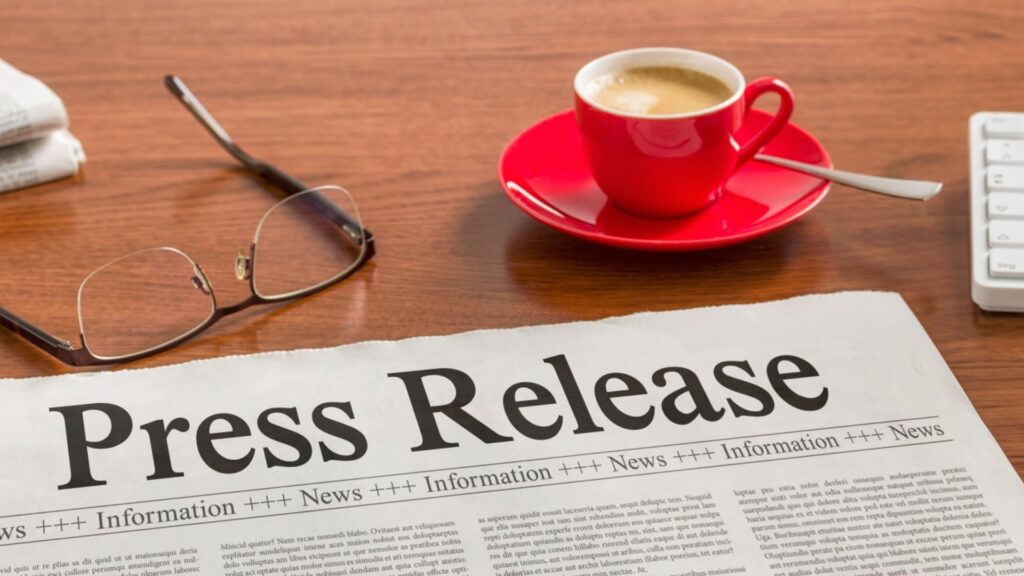
Key Takeaways:
- A rebrand press release sets the tone for how the new identity will be perceived by stakeholders.
- Clear and comprehensive communication can minimize confusion among your audience and maintain brand loyalty.
- Emphasize the improvements and benefits that come with the new brand identity, as well as provide a timeline of what to expect during the transition period and any steps customers need to take.
In the dynamic business landscape, rebranding can be a pivotal move towards growth and maintaining relevance. The success of a rebranding effort often depends on how effectively it’s communicated to the public. A well-crafted press release is essential, serving as the cornerstone of your rebranding strategy and setting the tone for how your new identity will be perceived by stakeholders, customers, and the media.
This article will guide you through the process of creating an impactful rebrand press release, from understanding its purpose to avoiding common pitfalls. We’ll ensure you have all the tools necessary to announce your rebranding with confidence and clarity, supported by relevant studies and research.
The Purpose of a Rebranding Press Release
A rebranding press release is a formal announcement that communicates your company’s decision to change its brand identity. It’s more than just a news item; it’s a strategic tool in your corporate communication arsenal. The primary goals of a rebrand press release are multifaceted and play a crucial role in ensuring the success of your rebranding efforts.
1. Keeping Employees, Investors, and Partners in the Loop
A rebrand represents a significant shift in your company’s trajectory and vision. It’s essential to keep key stakeholders, including employees, investors, and partners, informed about these changes. Transparency fosters trust and helps prevent misinformation or rumors from spreading. According to a report by Edelman, 68% of employees trust their company more when they are regularly updated on significant changes.

By clearly communicating the reasons behind the rebrand, you ensure that everyone involved understands the motivations and goals, which can lead to increased support and enthusiasm. For employees, this can mean feeling more connected and motivated, knowing they are part of an evolving and forward-thinking organization. Investors and partners, on the other hand, can make informed decisions based on the company’s new direction and strategic objectives.
2. Shaping How the Rebrand is Viewed by Customers and the General Public
Public perception is a powerful force in the success of a rebrand. A well-crafted can shape how your new brand identity is perceived by customers and the general public. This is your opportunity to frame the narrative and highlight the positive aspects of the rebranding effort.
Studies by Nielsen show that 84% of consumers say they trust recommendations from friends, family, and peers over other forms of marketing. This trust can extend to how they perceive your brand’s rebranding announcement if it’s shared positively in their networks. Use your press release to emphasize the improvements and benefits that come with the new brand identity, such as enhanced products, better customer service, or a renewed commitment to social responsibility. By doing so, you can positively influence public perception and generate excitement around your brand’s new chapter.
3. Minimizing Confusion and Maintaining Brand Loyalty
One of the primary purposes of a rebranding press release is to ensure a smooth transition from the old brand identity to the new one. Clear and comprehensive communication can minimize confusion among your audience and maintain brand loyalty.
A smooth transition involves more than just announcing the change; it requires detailed explanations and reassurances. Explain the reasons behind the rebrand, what it entails, and how it will affect customers and stakeholders. For instance, if your rebrand includes changes to product lines or services, clarify these changes to avoid any misunderstandings. Research by Accenture indicates that 66% of consumers care more about the brand experience than just the product. Ensuring that your audience understands and feels positive about the rebrand can help maintain their loyalty and trust.

Moreover, provide a timeline of what to expect during the transition period and any steps customers need to take, such as updating their accounts or accessing new services. This proactive approach not only helps in retaining existing customers but also positions your brand as organized and customer-centric.
In conclusion, a compelling rebranding press release is a vital component of your rebranding strategy, serving multiple purposes that contribute to the overall success of your rebranding effort. By effectively informing stakeholders, shaping public perception, and ensuring a smooth transition, you can set the stage for a successful and impactful rebrand.
Timing Your Rebrand Press Release is Crucial
Announcing a rebrand is a significant event that requires strategic planning and precise timing. To maximize the impact and effectiveness of your rebrand press release, consider the following factors:
1. Create a Cohesive Launch Strategy:
Your rebranding announcement should not exist in isolation. It should be part of a broader, well-coordinated marketing campaign that aligns with your overall business objectives. By integrating the press release with other marketing efforts, such as social media campaigns, email newsletters, and advertising, you can create a unified and compelling message.
For example, a study by McKinsey & Company highlights that companies with cohesive marketing strategies see up to 20% more revenue growth. A coordinated approach ensures that all touchpoints deliver a consistent message, reinforcing the new brand identity across all channels. This can include teaser campaigns leading up to the announcement, synchronized social media posts, and a dedicated landing page on your website explaining the rebrand in detail.
2. Prevent Your Announcement from Being Overshadowed:
Timing is everything when it comes to capturing attention. Announcing your rebrand during major holidays or busy news periods can result in your message getting lost amidst the noise. Research from PR Newswire indicates that press releases have higher engagement rates on weekdays, particularly mid-week.

3. Avoid major holidays or busy news periods:
Plan your announcement for a time when there are no major events or competing news stories that could overshadow your rebrand. This increases the likelihood that journalists and your target audience will notice and engage with your press release. Additionally, consider time zones and global reach if your company operates internationally, ensuring the announcement is made at a time that is optimal for your primary markets.
Ensure All New Brand Elements Are Ready for the Public
Before making your rebranding announcement, it is crucial that all new brand elements are finalized and ready for public unveiling. This includes your new logo, color scheme, tagline, website redesign, and any other visual or messaging components associated with the rebrand.
A report by Lucidpress shows that consistent brand presentation across all platforms can increase revenue by up to 23%. Ensuring that all elements are cohesive and polished before the launch prevents any inconsistencies that could confuse or alienate your audience. It also demonstrates professionalism and attention to detail, reinforcing the positive attributes of your new brand identity.
Before Announcing, Confirm You Have:
1. Finalized New Brand Elements (Logo, Color Scheme, Tagline):
Ensure that all visual and messaging components of your new brand are complete and approved. This includes everything from your logo and color palette to your tagline and brand voice. Consistency across all these elements is key to creating a strong and recognizable brand identity.

2. Clearly Defined Reasons for the Rebrand:
Clearly articulate the reasons behind your rebrand. Whether it’s to reflect a change in company direction, to better align with market trends, or to address new customer needs, having well-defined reasons helps to justify the change and make it relatable to your audience. A Harvard Business Review article emphasizes the importance of a purpose-driven brand, stating that customers are more loyal to brands that have a clear and meaningful purpose.
3. A Solid Vision for the Company’s Future Direction:
Outline a clear vision for the company’s future post-rebrand. This vision should convey how the new brand identity will drive the company forward, align with its strategic goals, and continue to meet or exceed customer expectations. Having a compelling vision not only motivates internal stakeholders but also inspires confidence and excitement among customers and partners.
In conclusion, meticulous planning and timing are crucial for a successful rebrand announcement. By coordinating with other marketing efforts, choosing the optimal time, ensuring readiness of new brand elements, and confirming all necessary components are in place, you can maximize the impact of your rebrand press release and set the stage for a successful transition.
Key Elements of an Effective Rebrand Press Release

1. Headline:
Craft a compelling headline that captures attention and conveys the essence of your rebrand. For example: “TechCorp Unveils Bold New Identity to Reflect Innovation-Driven Future”
2. First Paragraph:
Answer the crucial who, what, when, where, why, and how of your rebrand to set the stage for the rest of the release.
3. Body Content:
- Provide a detailed explanation of why you’re rebranding and the benefits it brings to customers and stakeholders.
- Include quotes from key company representatives, such as the CEO or Brand Manager, to add authority and a personal touch.
- Use relevant data or statistics to support your rebrand decision, if applicable. For instance, a survey by Rebrandly found that 74% of rebranded companies saw a positive impact on their bottom line.
4. Boilerplate:
Briefly describe your company, its mission, and vision post-rebrand to contextualize the changes for those unfamiliar with your organization.
5. Contact Information:
Provide clear contact details for your PR representative or the person handling media inquiries about the rebrand.
Writing Style and Tone

Maintain a professional tone that aligns with your new brand identity. Use persuasive and positive language to frame the rebrand as an exciting development rather than a necessary correction. Keep your writing clear and concise, avoiding jargon that might confuse your audience.
Distributing Your Press Release
Consider multiple channels for distribution:
- Traditional media outlets
- Online press release services
- Social media platforms
- Direct communication with key stakeholders
Choose channels that best reach your target audience. After distribution, follow up with key media contacts to ensure they’ve received the release and offer additional information if needed.
Measuring the Impact of Your Rebrand Press Release

Use tools like media monitoring software, social media analytics, and web traffic data to assess the effectiveness of your press release. Look for:
- Media pickup and coverage
- Social media engagement and sentiment
- Increases in website traffic or brand searches
According to a study by Cision, 63% of PR professionals measure success by the number of media impressions, highlighting the importance of tracking media coverage.
Common Mistakes to Avoid
When crafting your rebrand press release, it’s essential to avoid common pitfalls that can undermine your message and impact. Here are some detailed insights into these mistakes and how to steer clear of them:
Being Too Vague
One of the biggest mistakes companies make is failing to clearly articulate why they are rebranding. Vague explanations can lead to confusion and speculation, which can harm your brand’s reputation. According to a study by Branding Strategy Insider, clarity and transparency are crucial in rebranding efforts. Be explicit about the motivations behind the change, whether it’s to better reflect your company’s evolution, align with new market opportunities, or differentiate from competitors. Providing a detailed rationale helps stakeholders understand and support the transition.

Neglecting to Address How the Rebrand Benefits Customers
A rebrand isn’t just about changing your logo or color scheme; it’s about improving the overall customer experience. Failing to communicate the benefits of the rebrand to your customers can lead to disengagement and dissatisfaction. Highlight how the new brand identity will enhance your products or services, improve customer service, or provide additional value. For instance, if your rebrand involves adopting more sustainable practices, emphasize how this commitment to sustainability benefits your customers and the environment.
Using Overly Technical Language or Industry Jargon
Using complex terminology and industry-specific jargon can alienate your audience and obscure your message. A study by Forbes found that clear and simple language is more effective in business communications. Ensure your press release is accessible to a broad audience by using plain language and explaining any necessary technical terms. This approach not only makes your message more relatable but also enhances understanding and engagement.
Failing to Provide Adequate Contact Information for Follow-Up Queries
Your press release should include comprehensive contact information to facilitate media inquiries and stakeholder questions. Failing to provide this information can lead to missed opportunities for coverage and engagement. Include the name, phone number, and email address of your PR representative or a designated contact person. This ensures that journalists and interested parties can easily reach out for additional information, interviews, or clarifications.
Overlooking the Timing of Your Release
Timing is critical in ensuring your rebrand press release gets the attention it deserves. Releasing your announcement during busy news periods or holidays can result in it being overlooked. Research from HubSpot suggests that mid-week days, particularly Tuesday to Thursday, are optimal for press releases. Additionally, coordinate your release with other marketing efforts to create a unified and impactful launch. Ensure all new brand elements are ready and aligned before making the announcement to avoid any last-minute inconsistencies or confusion.
By avoiding these common mistakes, you can ensure your rebrand press release is clear, compelling, and effective in communicating your brand’s new direction.
Conclusion
A well-crafted rebrand press release is a powerful tool for communicating your company’s evolution. It sets the stage for how your new identity will be perceived and can significantly impact the success of your rebranding efforts. By following these guidelines, you can create a compelling announcement that not only informs but also excites your audience about your brand’s new chapter.
Remember, rebranding is more than just a change in logo or color scheme—it’s an opportunity to redefine your company’s place in the market. Embrace this chance to tell your brand’s story in a new and engaging way, and use your press release as the first step in what could be a transformative journey for your business.
